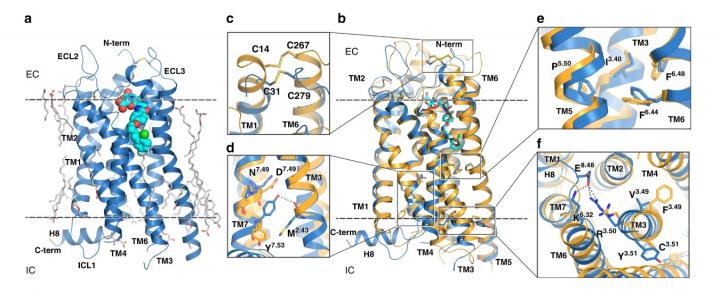
Credit: Anastasiia Gusach et al./Nature Communications
Biophysicists from the MIPT Center for Molecular Mechanisms of Aging and Age-Related Diseases have teamed up with colleagues from Canada, the U.S., Japan, France, and Germany to shed light on the structure and functioning mechanism of the CysLT receptors, which regulate inflammatory responses associated with allergic disorders. Their findings are reported in Nature Communications.
Cellular communication refers to the interactions between cells in an organism. It allows millions of cells to work together, managing bodily processes that are crucial for survival. Cells communicate via protein molecules called receptors, which exist on the cell and organelle surfaces, as well as in the cytoplasm. When a receptor binds a particular molecule, this triggers a specific response. A molecule that binds to a specific receptor is called a ligand.
G protein-coupled receptors, or GPCRs, are molecular machines incorporated into cell membranes. CysLT1R and CysLT2R are members of the GPCR family. Their ligands are highly potent lipids called peptide (cysteinyl) leukotrienes, or CysLTs.
Both of the receptor subtypes CysLT1 and CysLT2 are known to regulate allergic inflammatory responses. For over two decades, asthma and associated conditions have been treated with drugs that inhibit the CysLT1 receptor. Many patients, however, do not respond to this treatment. At the same time, the role of the CysLT2 receptor in the physiology and pathogenesis of the inflammatory response remains poorly studied. It was not until recently that CysLT2R was suggested as a potential drug target in the treatment of atopic asthma, brain injury, and central nervous system disorders, as well as certain cancers.
As of today, the development of more effective medications for asthma and associated conditions is hindered by the lack of information on how and to what ligands the CysLT receptors bind. Their functioning mechanisms have not been clearly understood either, as this requires high-resolution structural biology data. Once these are available, researchers can proceed using computer simulations.
In molecular modeling, docking is a method for determining the preferred orientation and conformation of the ligand within the protein binding site. Knowing the spatial structure of a given receptor with angstrom precision, as well as the chemical structure of the ligand, enables biologists to predict the spatial structure of the corresponding receptor-ligand complex and calculate the free energy of its formation. Hence, determining the spatial structure of such complexes is crucial to understanding their function.
In their recent study, researchers from the Moscow Institute of Physics and Technology identified the most critical ligand-binding determinants of the CysLT1 and CysLT2 receptors based on the structural analysis the team performed for CysLT2R and the structural data on CysLT1R published by the laboratory in October.
“The new structures have greatly improved the accuracy of ligand docking and helped us better understand the properties of ligands with respect to both receptors. Now we know how to alter drug design templates to inhibit the activity of both the CysLT1 and CysLT2 receptors or do that selectively for either of them,” commented Anastasiia Gusach, a PhD student at MIPT and a junior researcher at the MIPT Laboratory of Structural Biology of G Protein-Coupled Receptors.
In the future, these structures could be further developed to serve as drug candidates or tool compounds, aiding in understanding the specific role of each of the CysLT receptor subtypes in various physiological and pathological processes.
“Recently obtained results suggest that addressing both the CysLT1 and CysLT2 receptors as a drug target or even inhibiting CysLT2R alone will offer a more effective alternative to CysLT1R-selective drugs, especially in severe asthma cases. In addition, CysLT2R is emerging as a potential drug target for patients with brain injury and neurodegenerative disorders. All of the above makes CysLT2R promising for research. In this study, we described four crystal structures of CysLT2R in complex with three ligands blocking the CysLT1 and CysLT2 receptors,” said Alexey Mishin, a senior researcher at the MIPT Laboratory of Structural Biology of G Protein-Coupled Receptors.
Another great application of the structural information obtained in the study is the possibility to rationalize the effects of point mutations in which a “foreign” amino acid appears in the amino acid sequence of a protein, which in turn influences receptor activity. For this reason, the researchers accumulated information on mutations in the sequence of the CysLT2 receptor from 60,000 healthy individuals and mapped the positions of the new amino acids on the receptor structure. They found that about a quarter of these mutations were located in functionally important regions and may influence what processes the receptor will activate or deactivate when it interacts with its ligand.
This implies that with the rapid development of genome sequencing technologies and the accumulation of large volumes of statistical data, structure-function studies will not only allow accurate prediction of disease for every patient but will also enable predicting drug efficacy and improving patient safety based on how these variations in genes affect the response to certain medications.
###
The study was supported by the Russian Science Foundation and the Ministry of Science and Higher Education of the Russian Federation.
Earlier this year, the researchers revealed the spatial structure of the CysLT1 receptor. There is a video where lead authors Anastasiia Gusach and Aleksandra Luginina discuss their research.
Media Contact
Ilyana Zolotareva
[email protected]
897-777-14699
Original Source
https:/
Related Journal Article
http://dx.




